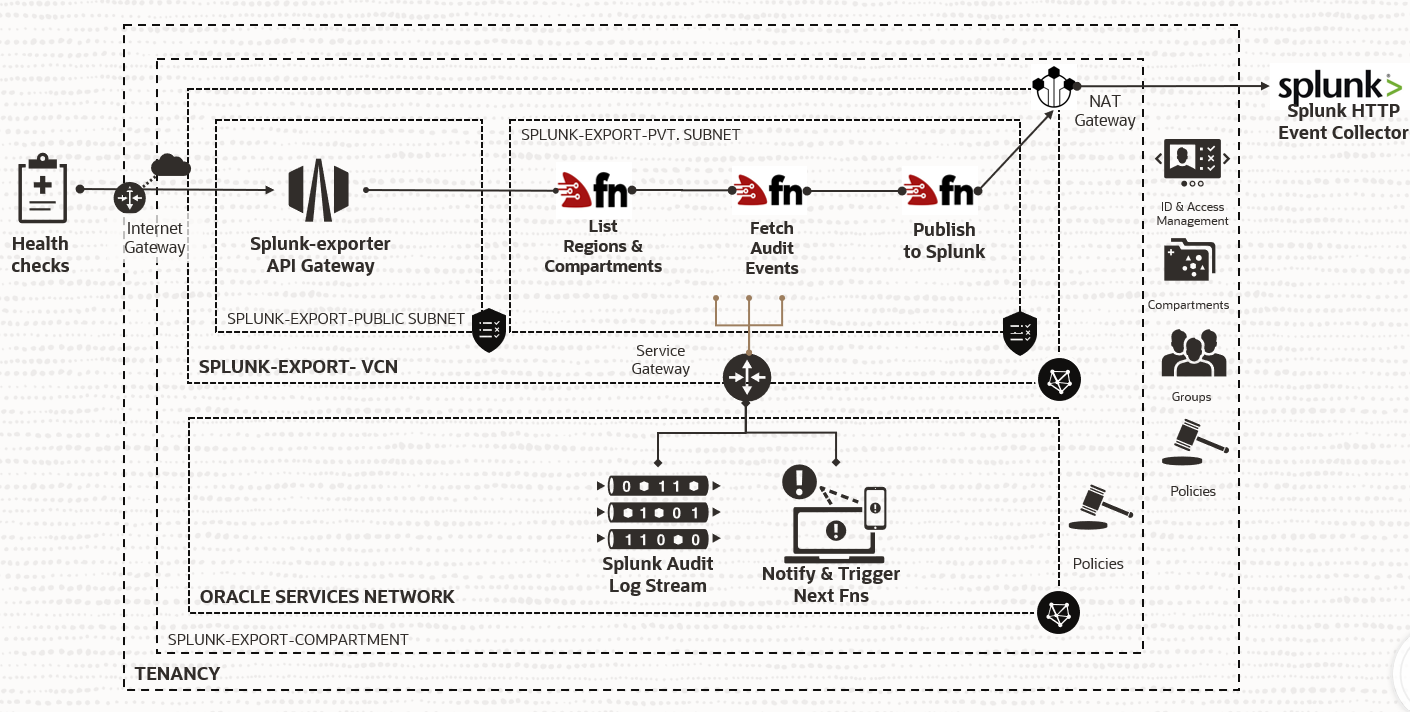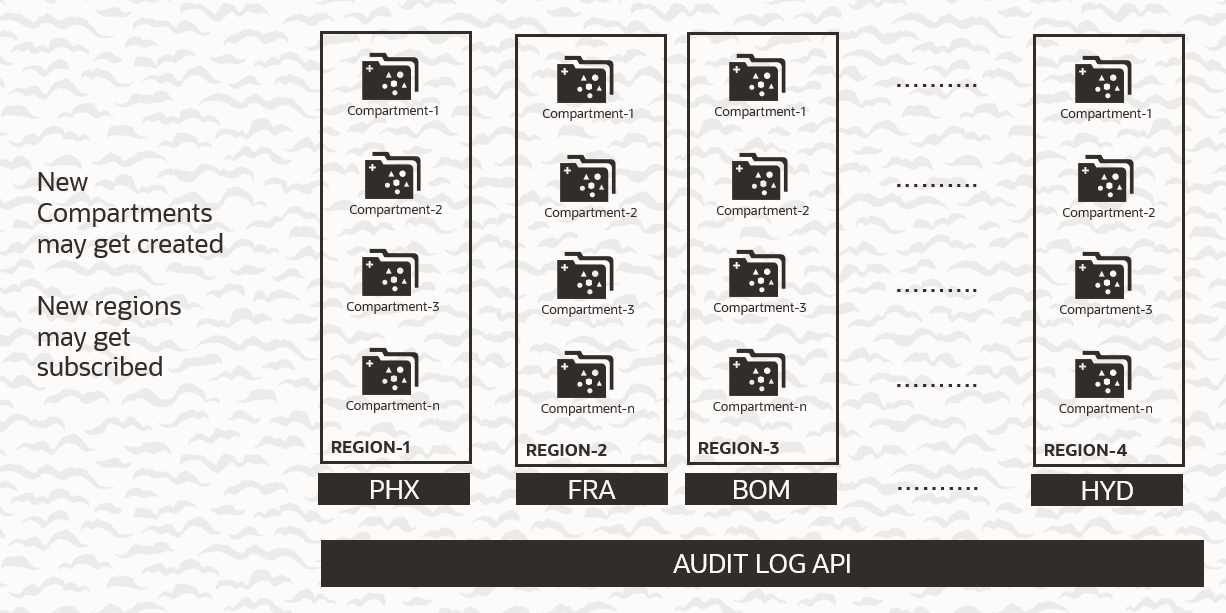Delivering a low-cost, scalable, audit events pipeline to a SIEM (Splunk | QRadar ) from Oracle…
Splunk is a SIEM tool used for Security Analytics. The article outlines the choice of components from Oracle Cloud Infrastructure to stream logs from Oracle Cloud Infrastructure to Splunk. Below are some data points

------------------------
STATISTICS
------------------------
Number of Data Centers / Regions in Tenancy - 4 Regions
Number of Compartments in each Region - 96 Compartments
Number of Federated Users - 82 Users
Number of Resources audited in tenancy - 1921 Resources
{'region': 'ap-mumbai-1', 'resource_count': 827}
{'region': 'eu-frankfurt-1', 'resource_count': 342}
{'region': 'us-phoenix-1', 'resource_count': 752}
Number of Audit events generated / day - 1 Mio. + Events

Overall Cost/Month $
------------------------------
Oracle Health Checks - 0.3 $
Oracle API-Gateway - 3.0 $
Oracle Notifications - 1.2 $
Oracle Functions - 3.0 $
Oracle Streaming - 2.0 $
-------------------------------
Overall Cost ~ 10 $
-------------------------------
For the Impatient
Link to the source code and implementation tutorial for those who know what this means and just wants to get this working. vamsiramakrishnan/splunk-export-audit *For Integrated SecOps , the SIEM plays an important component and Splunk is a very popular SIEM solution. The setup…*github.com
For the others — What is a SIEM
SIEM Stands for
(S)ecurity (I)nformation & (E)vent (M)anagement
Think of the SIEM as a single source of truth for all kinds of Security Events.
For table stakes, what a SIEM will have for sure are
1) Event Ingestion
----------------
Logs/ Events from multiple sources, Network - Subnets, Gateways, Load Balancers, Firewalls, WAFs, Identity Systems - Auth, Configuration Logs etc.
2) Event Processing
----------------
Event Processing is mostly log parsing & enriching log data into a searchable and indexable format.
1) Event Indexing & Search
---------------------------
A Combination of In-Memory, Relational, Document oriented data persistence and archiving layers to provide search functionality.
1) Pattern Building for Correlation
------------------------------------
All the components mentioned above are pre-requisites , this is where the SIEM actually provides benefits correlating between multiple events.
1) Analytics
-------------
A Series of dashboards, reports ad-hoc and periodic reporting
— — — — — — — — — — — — — — — — — — — — — — — — — — — — — — —
This article focusses on getting OCI AuditEvents to that single source of truth for security as soon as possible, at the lowest cost, in a pay-per-use pattern and can scale massively.
— — — — — — — — — — — — — — — — — — — — — — — — — — — — — — —
SIEM Trivia — Security Experts please skip.
The SIEM was born out of a necessity to reduce the complexity of correlating logs from multiple Intrusion Detection & Prevention Systems — Firewall Appliances, Switches, Routers etc.
SIEMs as an initiative became mainstream at the majority of institutions started off as a compliance-driven initiative and then evolved to become a fully functional SOAR.
 Stages of SIEM Implementation
Stages of SIEM Implementation
About OCI Audit Events
1) Every CRUD Action on any Oracle Cloud Service is an API Request - Response.
2) The Audit Store logs every Request-Response Interaction with additional metadata in a searchable Persistence Layer.
3) OCI Abstracts this Audit Store as an API for it's customers to Consume.
Some Defining Principles
Audit-API is regional
The Audit Logs of us-ashburn-1 has to fetched from the Audit API End Point from us-ashburn-1 only!
OCI IAM Constructs are Global653
A Compartment/IAM Policies/Groups/Users when created in one-region is created in all-regions automatically.
Audit Events from
All Regions, All Compartments, Every (1min/5min/10min) etc,
The Push Model and Pull Model
The Push/Pull Nature of the architecture is determined by the initiator.
Push Model
The System that generates events pushes data to a listener on the SIEM Side.
Pull Model
The SIEM pulls data from a listener where the System publishes generated events
The Protocol
The protocol for publishing is chosen based on the system that produces the event and most SIEM tools have predefined settings based on the source of data ( 500+ Sources ) and the kind of data it publishes
STANDARDS- PUSH
Syslog
HTTP(S) Receiver/Collector
SNMP
STANDARDS- PULL
JDBC
FTP
SFTP
SCP
Kafka
Log Parsing Formats
The Log formats are usually standards-based but if the source has a custom log format one would configure, the parsing logic based on RegEx, *WildCards, Separators etc
*
STANDARD FORMATS
*
LEEF
_JSON
TSV
CSV
RAW
SYSLOG
The Data Pipeline
 The Big Picture
The Big Picture
How is this implemented in OCI

What is the role of Notifications
Notifications are a means to de-couple functions from one another even if they are a part of the same pipeline. Rather than invoking a function directly from another function we use notifications to trigger functions. This allows one function to terminate without waiting for the subsequent functions to complete execution.
REGIONS AND COMPARTMENTS Fn
*
Case : 10 Regions in tenancy subscription, 10 Compartments/Region
Logic:
Fetch Compartment & Region IDs from 10 Regions x 10 Compartments
Split the 100 - ( Region-x, Compartment-x, Start Time, End Time)
Into batches of 25 , 10 /25 = 4 Batches
Write to Stream in 4 Batches
Publish 4 Notifications
4 parallel copies of downstream function are Triggered.
Info sent in Notifications:
Start Offset of Batches, Size of Batch
What is the role of Streaming
Streaming allows us to publish messages in an append-only format using a distributed commit log. Since functions are stateless, OCI Streams allow us to store state reliably and preserve context as functions execute and die. The current example uses a single partition, but we could very well use multiple partitions if it exceeds the 1 Mb/Sec write limit and the 2Mb/Sec Read Limit per partition.
FETCH AUDIT EVENTS Fn
Case : Recieved a batch of 25 Region x Compartment Tuple to Query from the Notification Trigger
Logic:
Fetch Audit Events from 25 Region, Compartment Pair
Assume, each Compartment in each region generates 10 events
25 x 10 = 250 Events
Split the 250- ( Audit event in json )
Into batches of 25 , 250/25 = 10 Batches
Write to Stream in 10 Batches
Generate the Partition ID, Offset, Number of Records to Read
This is also known as Cursor Information
What gets published in Notifications & what gets published in streaming
Streaming is where the actual audit events are written.
Notifications are leveraged to tell the next function where the events are written a.k.a offset, partition, number of records and

Are functions mandatory here?
No, you could very well package the same code that interacts with the OCI API to fetch audit events and publish them to Splunk across all regions and compartments. The reason for using functions is that it is purely event driven and aligns well with the fact that audit events don’t get generated continuously and rather when users interact with the cloud API
The job of Functions can be done by a container running inside a private Kubernetes Cluster as well.
What are the Design Goals
1. Must require Zero maintenance
2. Must be able to handle huge volumes of data
3. Must be able to handle changes in tenancy
4. Must be low-cost
5. Must be able to push data to Splunk as fast as possible
 Handling changes in tenancy
Handling changes in tenancy
The Components Used and How much do they Cost?
- All Costs Chosen are from the Public Website and are subject to change as per Oracle’s policy.
- Approximations have been applied

Salient Features
-----------------
* Helps schedule Functions at a low cost
* Also provides visibility into if the pipeline is running well.
* Pay-per-use
* Zero Maintenance
Supported Intervals - 30s, 60s, 5min
Cost/Endpoint* - *30 Cents/ Month*
*Qty Reqd.* *1
Overall Cost
-------------
0.30$ Per Month

Salient Features
----------------
* Provides a Secure HTTPS Endpoint to Trigger Functions
* Pay-per-use
* Zero maintenance
Cost/ Endpoint - 3$ per 1 Mio. API Calls per Month
Qty Required - 1 Gateway , with 8928 API Calls / Month
Calculation
------------
* Schedule API Call to fetch audit events Once every 5 Min.
* 12 API Calls / Hour
* 744 x 12 API Calls / Month
* 8928 API Calls / Month
Overall Cost
-------------
3$ Per Month

Salient Features
----------------
* Provides a Simple way to Trigger Downstream Functions
* Can be called from Fns itself in an easy way
* Allows for a good fire- and forget mechanism
* Pay-per-use
* Zero Maintenance
Cost/ Endpoint - 0.60$ per 1 Mio. Deliveries per Month
Qty Required -
Calculation
------------
* For a tenancy that has 96 Compartments & 4 Regions
List-Regions - Stage-1
----------------------
* Every 5 Min, the list-regions function produces a list of
96 x 4 = 384 Tuples
* The list-region function Splits 384 into batches of 25
384/25 = 16
* Publishes 16 Notifications in a 5 Min Interval Window
* 16 x 12 Notification Calls / Hour
* 744 x 192 Notification Calls / Month
* 142,848 Notification Calls / Month
Fetch-Regions - Stage-2
----------------------
Assuming 10 Audit Events/ Compartment/ Region / 5 Min Window
10 Audit Event x 96 compartments x 4 regions
3840 Audit Events / 5 Min Window
* The fetch-audit-event function Splits 3840 into batches of 25
3840/25 = 154 Batches
* Publishes 154 Notifications in a 5 Min Interval Window
* 154 x 12 Notification Calls / Hour
* 744 x 1848 API Notification Calls / Month
* 1,374,912 Notification Calls / Month
Overall Requirements
---------------------
* Overall = Stage-1 + Stage-2
* 1,517,760 Notification Calls/ Month
Overall Cost
-------------
1.2 $ / Month

Salient Features
----------------
* Keep Calm ! Write Code and Execute Code
* Massively Parallel & Massively Scalable
* Pay-per-use
* Zero Maintenance
Cost-
0.20$ per 1 Mio. Function Invocations per Month
0.1471 for 10,000 MB Seconds of execution time
Qty Required -
Calculation
------------
* For a tenancy that has 96 Compartments & 4 Regions
* On an average of 130k Fn Invocations/ Per Day
* On an average of Execution Time 1.48 x 10^7 MB_MS Per Day
* 1 Day cost = 1.48 x10^7/10^9( MB_MS -> 10,000 GB_S)* 0.1417 *31
* Monthly Cost = ~ 3$/Month
Overall Cost
-------------
3 $ / Month

Salient Features
---------------
* Ease of Use System of Record
* Store Series of Events
* Massively Parallel & Massively Scalable
* Pay-per-use
* Zero Maintenance
Cost-
0.025 $ per GB of PUT/GET
0.0002$ per GB per Hr STORAGE
Qty Required -
Calculation
------------
* For a tenancy that has 96 Compartments & 4 Regions
* On an average of 1GB Of Audit Logs/Day
* 2 GB/Day x 0.025$/GB x 31 Days/Month = 1.8 $/Month
* 1 GB/Day * 24 Hrs/Day * 31 Days/Month * 0.0002$ /GB = .14$/ Month
Overall Cost
-------------
2 $ / Month

Overall Cost/Month $
------------------------------
Oracle Health Checks - 0.3 $
Oracle API-Gateway - 3.0 $
Oracle Notifications - 1.2 $
Oracle Functions - 3.0 $
Oracle Streaming - 2.0 $
-------------------------------
Overall Cost ~ 10 $
-------------------------------


 Kubernetes Playground on your laptop
Kubernetes Playground on your laptop